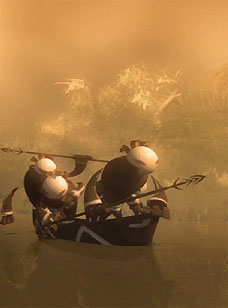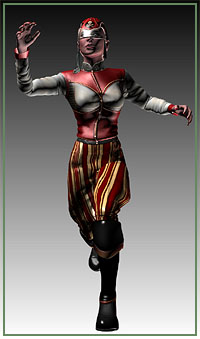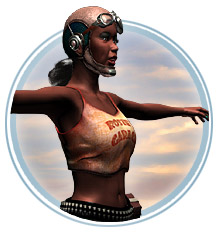

Samuel Tourneux’ Même les pigeons vont au paradis is a cautionary tale about an old man who’s sold an unlikely machine that will take him to Heaven, at the usual unreasonable cost. In that respect it’s highly realistic; the ending, though, is possibly less so. Normally the folks who sell you on that deal get the last laugh, of course. Not to mention giving you all sorts of messy and uncomfortable neuroses.
This short film has garnered a whole collection of awards and honors, and for good reason.
This entry was posted on Sunday, December 16th, 2007
and was filed under Computer Graphics, Found on the Web
There have been no responses »
 Whirlpool is a short animated film that retells an aboriginal Australian tale about a raid by the Saltwater People against the Freshwater People, and how the captives manage to get away.
Whirlpool is a short animated film that retells an aboriginal Australian tale about a raid by the Saltwater People against the Freshwater People, and how the captives manage to get away.
This is one of a series of twelve short animated films in the Dust Echoes series, produced by the Australian Broadcasting Corporation.
All twelve are adapted from tribal stories and the Dust Echoes site has a glossary and study guides which explain the background of the stories. The whole project is a very interesting one, and it’s great to see something like this produced.
Unfortunately this is a Flash web site so I can’t give you a direct link to the film. But it’s the leftmost of the film icons, just to the right of the “Explore” icon. Yet another demonstration of why Flash shouldn’t be used for site navigation. If you needed one, I mean.
This entry was posted on Thursday, December 13th, 2007
and was filed under Computer Graphics, Found on the Web
There have been no responses »
 Ars Technica continues its series on the history of the Amiga computer with Part Five – in which we see the machine and its inventors, apparently saved by an influx of cash from Commodore Business Machines, learn the awful truth.
Ars Technica continues its series on the history of the Amiga computer with Part Five – in which we see the machine and its inventors, apparently saved by an influx of cash from Commodore Business Machines, learn the awful truth.
The company wastes its resources in a completely bungled launch and the Amiga simply sits, unmarketed and practically unsold, for about two years before matters change and someone gains a clue about what to do with it. Meanwhile Jack Tramiel rushes the Atari ST to market and advertises it aggressively. The original Amiga engineers are split between those who move East to join Commodore and those who’ve already found that they’ve had enough.
The story so far:
This entry was posted on Monday, December 10th, 2007
and was filed under Computer Graphics, Found on the Web
There have been no responses »
 Here’s what makes me happy this morning – a jet packed penguin rocketeer by Fabio Bautista, modeled and rendered in 3DS Max. You just can’t keep a flightless bird down, even if he has to solve the immemorial “opposable thumbs” problem that’s stumped penguin engineers for centuries.
Here’s what makes me happy this morning – a jet packed penguin rocketeer by Fabio Bautista, modeled and rendered in 3DS Max. You just can’t keep a flightless bird down, even if he has to solve the immemorial “opposable thumbs” problem that’s stumped penguin engineers for centuries.
Bautista doesn’t have a web site of his own, but you can see his gallery – and a “Making Of” clip for this image and the brief “The Great Flight” animation – in his pages at CG Society, here.
This entry was posted on Sunday, December 9th, 2007
and was filed under Computer Graphics, Found on the Web
There have been no responses »
I’ve just run across this amazing presentation on YouTube – and as I dug a bit deeper, I found that one of the most amazing things about it is that it originated in 1999, to accompany a SIGGRAPH paper by Volker Blanz and Thomas Vetter. It’s not that 1999 is actually ancient history – it’s just that the technology behind this is so very interesting that I don’t understand why it hasn’t already worked its way down to commercial applications (unless it has – but more on that below).
This demo shows how a 3D database of 200 textured male and female faces was used as the foundation for a human face modeling system, and much more – among other things you’ll see how the software uses its raw data to extrapolate a 3D face from a single photograph. It even invented matching textures, whether the photo was in color or in black and white. The same techniques were used to generate expressions for the faces.
In the rest of this post I’m going to muse about what all this could mean. So in the interest of full disclosure I must admit to you that in my last post I mentioned that I was skinning a set of 3D characters, and that skinning characters – without fail – drives me insane. It doesn’t take much of a leap here for you to realize that you are probably reading the thoughts of a crazy person. So make of this what you like.
(more…)
This entry was posted on Sunday, November 4th, 2007
and was filed under Can't Stop Thinking, Computer Graphics
There have been 4 Responses »
 Always.
Has.
Always.
Will.
Always.
Has.
Always.
Will.
Days and days and days and days of insanity lie ahead. If you see me, kill me now.
This entry was posted on Saturday, November 3rd, 2007
and was filed under Computer Graphics, Works in Progress
There have been no responses »
Video 3000 is a short animated film by a group of five students from the Hochschule der Medien in Stuttgart. It was shown at Cannes earlier this year.
I’d really like for you to go watch it, but it would be better if I didn’t say much about why – you’ll have a better time, believe me.
What I can say is that the character animation is terrific. You’ll immediately relate to how Our Hero responds to the situation he finds himself in, and the various things he does are wonderfully well observed and animated.
This entry was posted on Monday, October 29th, 2007
and was filed under Computer Graphics, Found on the Web
There have been no responses »

HUGH is a fantastic short film by a group of four students from France’s École Supérieure des Métiers Artistiques. We see an Apache shaman telling some children a story about the days when the sky was so low that birds couldn’t fly, trees couldn’t grow, and adults had to walk with their backs bent and their eyes glued to the ground.
The “present day” scene of the storyteller is rendered in a wonderfully realistic but stylized manner – the characters remind me of the successful treatment of human characters in Ice Age – while the story itself appears in a completely different style that’s echoed n the decoration we see on the storyteller’s tent. From those creative decisions, through its execution, and including the animation and the voice and audio work, this is a first rate effort that’s head and shoulders above what you expect to see in a student film.
Here it is, in DIVX format, with English subtitles. Go look!
This entry was posted on Friday, October 26th, 2007
and was filed under Computer Graphics, Found on the Web
There have been no responses »
 After a hiatus – which followed a bit of a letdown in Part 3 – Ars Technica’s History of the Amiga continues in Part 4 – once more in fine form. We get the background on both Jack Tramiel and Irving Gould and follow Amiga Inc. through near-disaster to its apparent salvation at the hands of Commodore.
After a hiatus – which followed a bit of a letdown in Part 3 – Ars Technica’s History of the Amiga continues in Part 4 – once more in fine form. We get the background on both Jack Tramiel and Irving Gould and follow Amiga Inc. through near-disaster to its apparent salvation at the hands of Commodore.
Some props are given to Carl Sassenrath for the Amiga kernel and his plans for the OS; we see some pushing and shoving in the decision on how much RAM to include in the machine; and we get a vivid description of the Amiga’s launch event, complete with Debby Harry and Andy Warhol.
And perhaps most importantly we see how the world at large received the news. There’s a pointed contrast with the other machines then available and a bit of prescience about how these outlandish features would one day become commonplace. Good reading.
This entry was posted on Monday, October 22nd, 2007
and was filed under Computer Graphics, Found on the Web
There have been no responses »
 It’s still all about the girls here in the Secret Laboratory. Though not the way you think, which I guess is sort of unfortunate.
It’s still all about the girls here in the Secret Laboratory. Though not the way you think, which I guess is sort of unfortunate.
Nope, I’m continuing my work on a set of characters who are all retro-futuristic and are all, not to put too fine a point on it, Babes. Dames. Skirts. Frails.
I’ve done a bit more work with Crazy Bump, the normal map maker I mentioned earlier, and I’m liking it more than ever.

This entry was posted on Tuesday, October 9th, 2007
and was filed under Computer Graphics, Works in Progress
There have been no responses »














 Always.
Has.
Always.
Will.
Always.
Has.
Always.
Will.





 It’s still all about the girls here in the Secret Laboratory. Though not the way you think, which I guess is sort of unfortunate.
It’s still all about the girls here in the Secret Laboratory. Though not the way you think, which I guess is sort of unfortunate.
